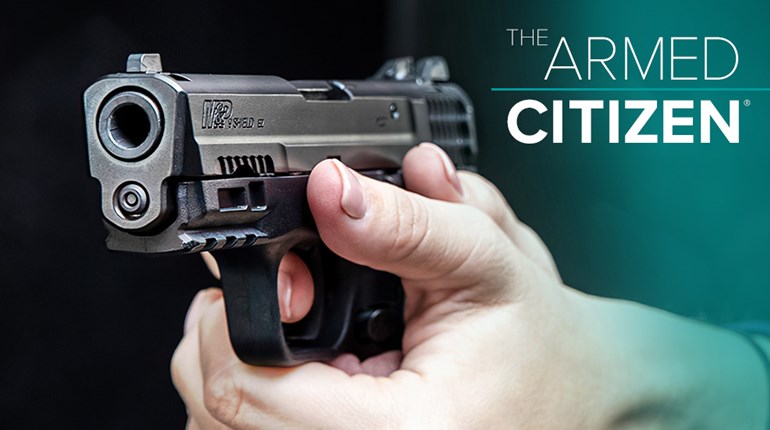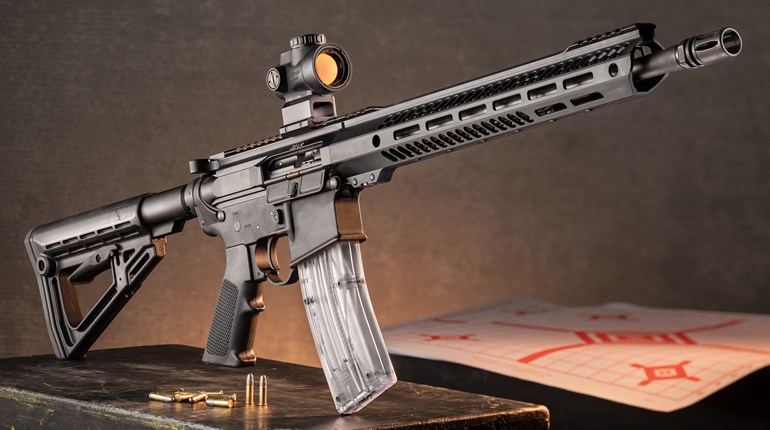
Once you’ve started reloading your own ammunition, you might find yourself at the range a bit more frequently. (The joke is that you don’t really save any money because you just shoot more.) If that’s the case for you, it might be time to upgrade to a progressive press.
Progressive presses combine several tasks into a single stroke and can produce more than 1,000 rounds an hour in some cases. Like any other complex machine, understanding how it works is critical to selecting the right one for your needs.
How They Work
Turning fired brass back into loaded ammunition requires the same basic steps we’ve previously gone over: resizing, repriming, expanding the case mouth (in some instances), replenishing the powder charge, seating and possibly crimping a bullet. A progressive press accomplishes all these tasks through the use of various stations, each with a unique die to perform one or more of these functions. And, instead of a shell holder for a single case, a shell plate holds as many as 10 in various stages of the reloading process. With each stroke of the handle, the ram presses each case into its respective die, completing the operation or operations. Before, during or after the stroke, the plate rotates, aligning each case with its next operation. Eventually, every station will be filled, and each stroke will then start and finish a round, creating an uninterrupted flow of ammunition.
Choose Your Level of Automation
Choosing the right press involves asking yourself how well you multitask and how much control you like. Those who can watch a complicated mechanical procedure and break down each individual stage should not be afraid of presses that have five or more stations. This gives you the ability to add specialty dies like powder checkers, a separate de-capping die and more. Great examples are the Hornady Ammo Plant or the Frankford Arsenal X-10.
If you’re the type who likes to keep things simple, go for smaller three- or four-station presses. These machines combine more tasks at each position, giving you less to keep an eye on. They also make great solutions for medium-volume cartridges, as their lower cost and smaller footprint make it realistic to buy a few and leave them set up. Presses like the Lee Pro 1000 or Dillon Square Deal “B” come to mind.
The second consideration is whether you want the plate to rotate automatically through the press linkage or if you prefer to manually rotate it. All of the aforementioned presses incorporate this rotation somewhere in the stroke, so there’s less to worry about; however, should something go wrong, there are a few more steps to go through to remedy the situation. Presses where you rotate the plate by hand might be a bit easier to work with in terms of troubleshooting, but they decrease output by a significant number of rounds per hour.
What About Accuracy?
By now, you’ve probably read that ammunition loaded on a progressive press is less accurate than the same ammo loaded on a single- stage press. While I’m not big on blanket statements, I can validate this. Let me begin by saying progressive presses create ammunition that is more than accurate enough to win any pistol sport and most rifle sports as well. Every year, NRA High Power and Service Rifle shooters at Camp Perry place higher than I can ever hope to on the leaderboard with ammunition that is rolled off using this “large-batch” method. The same holds true for the IDPA and USPSA nationals. Many Precision Rifle Series (PRS) shooters also use this method, but this is where the line starts to blur, as the league is divided on which presses do better for this sport. Nearly every serious benchrest shooter loads singularly; however, if you aren’t trying to squeeze five .30-caliber bullets through a .40- caliber hole, you can “get by” with a progressive.
Why is this so? There are two reasons for this: powder management and operational offset. Regarding powder, progressive presses rely on measures, which meter powder by volume, as opposed to the weighing method employed by the slower, single-stage process. This allows for a slight deviation from charge to charge. Progressive loaders are urged to stick to ball or flake powder, as the smaller kernels are better at repeating the same measurement from case to case.
This brings us to operational offset, which refers to the driving force from the ram being applied to the case at an angle. A shell plate hangs over the edges of the ram like a mushroom; with the case hanging off the extreme edge, pressure is applied at the center of the mushroom, but since the case is on the edge, it experiences a bit of flex during the operation. This leads to some inconsistency, but in most cases, it’s immeasurable. While technically offset is bad for accuracy, the vast majority of shooters will never notice it.
Tooling Up
When it comes to selecting a reloading press, there are several excellent options on the market. Take some time to research the aforementioned points to help you make the most- informed decision possible. Although reviews are helpful, dig deep and see what’s involved with changing your prospective purchase over to load a different cartridge. This is a possible sticking point for some shooters, and rightfully so, as some presses might take as long to swap as it does to make 100 rounds on a single stage. Don’t rush the decision; after all, whatever time you spend choosing will be made up for at the bench.

































